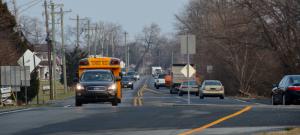Transportation planner and engineer Jeff Greene says it's not quite time to throw in the towel when it comes to easing traffic congestion in Lewes.
Showing a photo of Chicken Little proclaiming the sky is falling, he said, “We're not there yet.”
A traffic management study completed by Delaware Greenways for the Lewes Scenic and Historic Byway Committee was unveiled to the public during a Jan. 8 Sussex Act Now Delaware group meeting.
The study not only confirmed the traffic issues that everyone who lives or visits Lewes knows, it also offered possible solutions. “We can find room for people, but finding room for cars is the challenge,” Greene said. “About 10 percent of carrying capacity is left; we are going to find an answer.”
The study also revealed that most intersections on the key roads in Lewes are failing or close to failing.
And it's not only cars that add to traffic issues in Lewes. The city has become a mecca for bicyclists and pedestrians. To prove that point, Greene said over Labor Day, nearly 40 percent of the traffic on Gills Neck Road – part of the city's scenic byway – was bicycles – at more than 35 percent – and pedestrians. During some weekend peak hour weekend counts, the number of bicycles exceeded the number of vehicles.
The road serves as access to the popular Junction and Breakwater Trail between Lewes and Rehoboth Beach. A proposed connector trail to get people off the road is currently held up in court.
The traffic situation changes dramatically in Lewes – January traffic is half of July's, Greene said. In 2013, the average daily traffic on Savannah Road was 8,000 vehicles in February and nearly 18,000 in August.
Greene said roads can't be widened; the solutions to ease traffic congestion require that capacity be managed to spread out peak traffic and reduce the demand for more vehicles on the roads.
“It's a balance of demand and capacity,” he said.
Greene said reduction of demand can be accomplished by providing safe trails and pathways for pedestrians and bicyclists – including more sidewalks – to provide access to all areas in Lewes and to the state park.
Solutions include Lewes jitney service
The study made the following recommendations:
• Manage events that overcrowd city streets by staggering times and days and improving parking and traffic routing plans.
• Improve public transit by establishing a jitney service.
• Develop and implement a traffic management plan that includes better coordination between the city, county and state officials.
• Preserve and recognize the historic transportation rights of way. Lewes' designated scenic byway includes New Road, Kings Highway, Gills Neck Road, Savannah Road, Cape Henlopen Drive and Pilottown Road.
• Reduce demand for vehicles by completing planned bicycle and pedestrian trails and developing new ones.
• Improve visitor and traffic information services.
Greene said priority should be given to implementing a jitney service to provide transportation to key areas such as beaches, Cape Henlopen State Park, downtown points, Cape May-Lewes Ferry, remote parking areas, hotel and shopping areas and residential neighborhoods.
“The jitney is a real solution,” said Gail Van Gilder, president of the Lewes Scenic Byway Committee. “We need to move quickly, but we know cost is always the issue.”
Lewes intersections are failing
In summer, an average of 48,000 vehicles travel daily on Savannah Road, Kings Highway and New Road, a 2014 survey reveals. The Aug. 17 traffic survey, conducted by a team of 27 volunteers, was added to a city-sponsored traffic count in July and August.
Greene said the survey revealed that one-third of summer traffic coming from the Route 1 area on Kings Highway turns off to downtown Lewes while two-thirds of traffic travels onto Freeman Highway to the Cape May-Lewes Ferry or Cape Henlopen State Park.
The survey showed that Kings Highway at the Gills Neck intersection exceeds carrying capacity and Savannah Road intersections are nearing carrying capacity in the downtown area, particularly at the intersection near the Lewes-Rehoboth Canal bridge.
A one-hour count during a peak Saturday hour showed more than 1,500 vehicles at the Kings Highway-Gills Neck Road intersection. “And that's on a two-lane road,” Greene said.
Greene said carrying capacity is the amount of traffic when the system becomes congested and cannot accept more traffic without backing up.
Kings Highway is over capacity much of the day, Greene said, but he added that even small changes can equate to less congestion. Proposed changes by the Delaware Department of Transportation at the Kings Highway-Gills Neck Road intersection in front of Cape Henlopen High School will improve traffic patterns on the busy road, he said.
On the state's level-of-service rating scale, that intersection is rated F – a failing intersection – even when school is not in session. Greene said most other intersections on Kings Highway and Savannah Road are rated D or E, meaning close to failure.
Greene said level of service at an intersection is based on how long motorists have to wait to proceed from a stop.
He said computer models show many of the other intersections in Lewes are close to failure, and the numbers do not even include proposed development in the Gills Neck area, including a possible large commercial project near the intersection.
The one intersection that is not failing and has a significant amount of carrying capacity available is at Freeman Highway-Cape Henlopen Drive, partially because it has been improved with large turn and merge lanes.
Greene said New Road also has room for more carrying capacity.
More input on Lewes projects
Currently, many road improvements are funded by developers whose projects increase traffic. The required improvements are determined through meetings with state transportation officials and developers with the Delaware Office of State Planning Coordination Preliminary Land Use Service as a major stepping stone in the process.
Van Gilder said the byway committee now has a seat at the table and can comment on proposed road improvement projects that impact Lewes. “We'd rather comment when the plan is being written,” she said. “By the time the plan is written, it's difficult to make changes.”
Van Gilder said traffic improvements and road design should be sensitive to the city's designated byways. For example, she said, the committee supports several improvements to the aesthetics of Savannah Road and Kings Highway, the two main entrance roads to Lewes. One plan submitted by the committee includes a tree-lined boulevard with trails and a median to separate lanes on Kings Highway.
Van Gilder said the committee has reached out to Sussex County officials to create a better flow of information on proposed projects that affect Lewes. Deputy County Administrator Hal Godwin has agreed to serve on the byway committee. In addition, Van Gilder said, the county has agreed to flag plans proposed for a Lewes byway through its planning and zoning office to give committee members early notification.
She also said it's prudent for the committee to provide comments on the public record on proposed applications prior to planning and zoning commission hearings and to seek a meeting with developers before the public hearing process begins.
The committee is scheduled to make a presentation to county council at the 10 a.m. Tuesday, Jan 20 meeting.
THE HEARTBEAT OF LEWES TRAFFIC
Traffic engineer Jeff Greene said the key intersection to how traffic moves in and around Lewes is not one that most people would expect. He said the heartbeat to Lewes traffic is the block on Savannah Road between Third and Front streets because of the high interaction with pedestrians, bicyclists and vehicles. “If that area doesn't work, no one gets anywhere,” Greene said.
Greene said even a few vehicles per hour would push the intersections over carrying capacity.
BETTER ACCESS TO DOWNTOWN, BEACHES
The study offered the following nonmotorized ways to improve traffic flow:
• Construct the Georgetown-to-Lewes Rail Trail.
• Extend the sidewalk from Old Orchard Road across the railroad tracks
• Build continuous sidewalks from the end of Pilottown Road to the New Road intersection.
• Upgrade Fourth Street to a neighborhood greenway for better access to downtown.
• Improve Front Street crosswalk
• Upgrade shoulders on Cape Henlopen Drive to Savannah Road, with bicycle connections to Lewes beaches and to the proposed Georgetown-to-Lewes Rail Trail.
• Improve ferry and residential access along Cape Henlopen Drive to the proposed rail trail.
• Restripe Savannah Road for bike lanes on both sides and constructing a sidewalk on the northbound side of the road.
IMPROVEMENTS PLANNED FOR KEY INTERSECTION
Improvements at the Kings Highway-Gills Neck intersection expected to be completed in phases over the next year-and-a-half include the following; Separate left, through and right-turn lane onto northbound Gills Neck Road; right-turn deceleration lanes into the school and onto Gills Neck Road; left-turn lanes on Kings Highway; traffic signal modifications; extension of the shared-use pathway along Kings Highway; and additional bike lanes. The work will be funded by LT Associates, as result of development of the Senators subdivision.
WHAT IS CARRYING CAPACITY?
Carrying capacity is exceeded when a road is congested and cannot accept more traffic without backing up.
















































